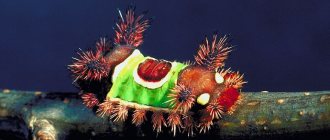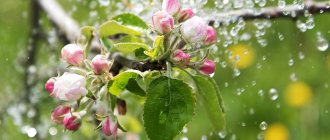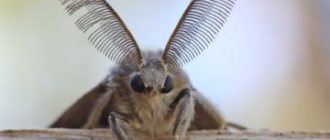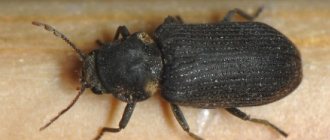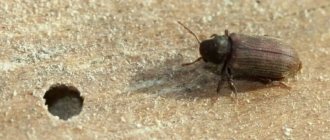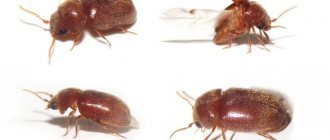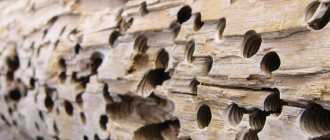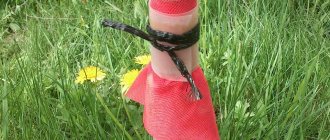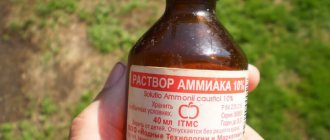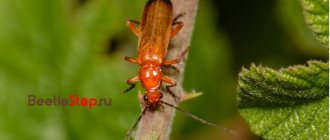Description of the woodworm
The butterfly of this species reaches impressive sizes: the wingspan of the female is 100 mm, the male is 70 mm. The color on different parts of the body varies:
- The forewings can be all shades of gray (sometimes with a brown tint) with a fuzzy gray-white marbled pattern, or dark wavy lines located across the wing.
- The hind wings have a rich dark brown tint, over which there are matte lines several shades darker.
- The chest is brown closer to the head, with a velvety black stripe running across it. Near the abdomen the shade becomes paler.
- The abdomen is dark gray, with clearly visible light gray scales.
In adult females, the retractable ovipositor is clearly visible, they are larger and thicker. The body and wingspan of the male are much smaller. Both individuals have a short, underdeveloped proboscis. The entire body of the woodworm butterfly is covered with short hairs.
The eggs of this pest have an elongated shape, reaching up to 1.5 mm in length. Their color is light brown with dark gray stripes. After hatching, the larvae (or caterpillars) reach impressive sizes - up to 80 mm in length and up to 12 mm in thickness. Their body is deep red in color, later it changes color to yellowish-red. The head and dorsal scutes are black. The caterpillars have a powerful jaw that can bite through human skin.
The peculiarity of this species is the pungent smell of wood vinegar, noticeable at a distance of several meters.
Dark brown pupae of the woodworm are found in cocoons made from wood pieces. Their size reaches 30 mm.
Butterfly larva
The birth of a butterfly is associated with a certain stage of insect development. After an adult has laid eggs in some secluded place, larvae emerge from them in the form of small worms. These worms are quite voracious creatures. They eat a lot of greens in order to move to another stage of development.
These larvae are called caterpillars. An insect can be a caterpillar for either several days or several years, depending on the species. Typically, each type of caterpillar eats a specific type of plant. They often become pests of any crops, fruit trees, berries, vegetables, fruits, etc. After a certain time, the caterpillar turns into a cocoon, which is called a pupa. Then an adult, called a butterfly, emerges from the cocoon.
Interesting to know! The larger the butterflies, the larger the caterpillars and vice versa.
All types of caterpillars may differ in size, development periods, colors, and habitats, but they all have the same body structure. The body structure of a caterpillar consists of:
- From a well-defined head of regular round shape, oral apparatus, visual organs and horn-shaped antennae.
- Breasts.
- Abdominal section.
- Several pairs of limbs.
As a rule, a caterpillar has at least 5-6 pairs of eyes located nearby. The mouth has several small teeth with which they chew plants. There are small hairs or spine-like growths on the body. As a rule, the caterpillar moves quickly along leaves, branches and other surfaces.
Range and habitats
The habitat of the woodworm is considered to be Europe (Eastern and Western), the Caucasus Mountains and Western Siberia. Occasionally, the insect can be found in North Africa and Asia Minor.
The main habitat is mixed and deciduous forests, trees located in floodplains, gardens and parks in cities. The Caucasus Mountains are inhabited by this insect right up to the upper border of the forests. In zones with a hot and arid climate, the wood borer lives in lakes or floodplains and is predominantly nocturnal.
Ocellated Hawkmoth
Speaking about butterflies that hatch from the pupa of the hawkmoth caterpillar, it should be noted that all representatives of the family of these unusual insects are considered quite rare, and many of them are listed in the Red Book. Their extermination can have serious consequences and is punishable by law. For example, the hawk moth. By the way, its larva is one of the most unusual: green with white stripes, located symmetrically relative to each other. This is a large green caterpillar with a horn on its tail that is pale blue in color. Speaking about the larva of the ocellated hawk moth, it must be said that the thorn of these insects is not at all for beauty, but for protection from annoying small brothers: ants and small bugs. It is something like a sting, which, like wasps, contains poison (acid) that affects the enemy. For humans, the “weapon” of the hawkmoth caterpillar does not pose any danger.
Life cycle
The life of this insect consists of four stages: egg, caterpillar, pupa and butterfly.
Egg
Adults lay eggs in late June-early July. They are placed in crevices and cracks in the bark of trees. Eggs are laid in several batches; the female fills each batch with a quickly hardening liquid. During its life, a butterfly can lay up to 1000-1300 eggs. This stage of the cycle lasts 10-12 days.
Caterpillar
Young hatched caterpillars live together, this is necessary for obtaining food and jointly cutting passages under the bark of trees.
The caterpillar burrows are filled with red-brown excrement. It is through them that the pest can be detected.
Caterpillars overwinter twice during their lives. For the first time - under the bark, with the onset of spring they awaken and begin to actively gnaw independent passages towards the center of the trunk. After the second winter, some of the caterpillars leave the tree and crawl across the surface of the ground in search of a place to pupate.
Doll
Pupation occurs at the end of May, in the second year of the caterpillar's life. The cocoon consists of pieces of bark, soil and silk threads produced by the larva. Its location is soil, stumps or tree bases. The pupation phase lasts for one month.
Butterfly
The life period of butterflies is July-August. They are especially active in the evening, after sunset. Females lay eggs in crevices of bark and wood and fill them with a sticky, quickly hardening substance. They do not require food to procreate. The number of eggs laid can range from 250 to 1300 pieces, on average, each butterfly lays about 1000 pieces.
Literature
- // Encyclopedic Dictionary of Brockhaus and Efron: In 86 volumes (82 volumes and 4 additional ones). - St. Petersburg. , 1890-1907.
- Zagulyaev A.K. Sem. Cossidae - Woodworms or cossids. / Insects and mites are pests of agricultural crops. T. 3, part 1. Lepidoptera. - St. Petersburg: Nauka, 1994. pp. 47-51.
- Rudnev D.F. The carpenter family is Cossidae. / Arthropod pests of agricultural crops and forest plantations (ed. Vasiliev V.P.). T. 2. - Kyiv: Harvest, 1974. P. 226-228.
- Savkovsky P.P. Atlas of pests of fruit and berry crops. - Kyiv: Harvest, 1976. 207 p.
- Chistyakov Yu.A. The carpenter family is Cossidae. / Butterflies are pests of agriculture in the Far East. Determinant (ed. Kirpichnikova V. A., Ler P. A.). - Vladivostok: Far Eastern Branch of the USSR Academy of Sciences, 1988. P. 55-60.
Wikimedia Foundation. 2010.
See what “odorous woodborer” is in other dictionaries:
- - (Cossus cossus), butterfly of the family. woodworms The wingspan is 75-104 mm. Widely distributed in the USSR in the forest zone. Flights in May-August, eggs are laid in groups (20-70) in crevices in the bark, most often of willow, poplar and fruit trees. Young caterpillars... ... Biological encyclopedic dictionary
- (Cossus ligniperda Fr.). A butterfly from the carpenter family Xylotropha, up to an inch long and as thick as a little finger. Brownish gray, with many dark wavy transverse lines and light indistinct spots on the wings. On the back behind the head... Encyclopedic Dictionary F.A. Brockhaus and I.A. Ephron
Butterfly with brown-gray wings. It flies in summer and lays eggs in crevices of tree bark. The caterpillars first live under the bark in old passages, then make new passages from the bottom up. Woodworm (x 13/4): 1 caterpillar entrance hole; 2 and 3... ... Agricultural dictionary-reference book - (Cossidae) a family of moths of the suborder heteroptera. The venation of the wings is primitive. Mostly large forms: in the fauna of the USSR up to 85 mm in wingspan, in Australia up to 220 mm. The coloring is varied; species of the Northern Hemisphere often ... Great Soviet Encyclopedia
The style of this article is non-encyclopedic or violates the norms of the Russian language. The article should be corrected according to the stylistic rules of Wikipedia... Wikipedia
WOOD BORROW
- (Cossidae) - a family belonging to the order Lepidoptera, which has about 800 species. These butterflies are distributed all over the world. Most often they are medium in size. The largest of them have wingspans up to 10 See The exceptions are those... ... Life of insects
A large, inconspicuous butterfly, similar to a night moth and, like it, leading a nocturnal lifestyle, can become quite a major nuisance for the garden. And it’s not even entirely about her. But the fact is that from the egg that is laid by this same butterfly with the picturesque name Woodworm, a large pink caterpillar hatches, and not just one, but a thousand, since the clutch of eggs is approximately 1000 pieces.
The odorous woodborer (Latin name Cossus ligniperda Fr.) is widespread throughout Russia. This caterpillar is quite harmful to some deciduous trees. In the first half of summer, the butterfly lays eggs in deciduous trees on the underside of the trunk. A bunch of eggs is carefully filled with resinous juice, which tightly holds the clutch on the surface of the trunk and protects it. The caterpillars hatch soon enough, eat the top layer of wood - the sapwood, and dive under the bark, where they quietly spend their first winter.
What does it eat?
The basis of the diet of the odorous woodworm is made up of deciduous species growing both in the garden and in the forest:
- willow;
- poplar;
- oak;
- alder;
- aspen;
- Walnut;
- Apple tree;
- pear;
- Rowan;
- Linden;
- white acacia.
The caterpillars feed on the bark and the wood itself, making passages and burrows in the trunk.
Most often, the pest damages species with soft wood or trees growing singly, as well as weakened and diseased plants.
Classification
Each butterfly was a caterpillar, and the color of the caterpillar may differ from the color of the butterfly. Most often, caterpillars are herbivorous insects, but predators can also be found in nature. Depending on their food, caterpillars are divided into the following classes:
Polyphages. This type of caterpillar feeds on almost any plant. They represent butterfly species such as wine hawk moth, blind hawk moth, kaya bear, peacock eye and other insects.
Monophages . These caterpillars prefer to eat only specific types of plants, which is where their names come from. Examples of monophages include cabbage moths, apple moths, silkworms and other species.
Oligophages. The food of these insects is limited to one type of plant that belongs to a specific family or type. As a rule, this is a pine butterfly, swallowtail, polyxena.
Xylophagous. The diet of this class is varied with various tree barks. Such caterpillars are leafworms, woodworms, and so on.
Caterpillars also differ in their distribution area. A number of species inhabit the subtropics, and some inhabit the northern regions. Among the large number of caterpillars, there are also quite valuable representatives, for example, silkworms. Silk threads are obtained from their cocoon.
Damage caused by woodworm
The main damage to trees is caused by caterpillars. Immediately after hatching from the eggs, they reach the young shoots and penetrate inside, to the core. As it grows, the pest's passages increase in length, first horizontally, damaging blood vessels and weakening the tree, then downward to the base of the trunk.
A tree affected by woodworm loses its attractiveness: shoots die en masse, leaves in the crown dry out and fall off. Yields of fruit crops are sharply reduced. The tree becomes weakened and cannot resist fungal and bacterial diseases. In the absence of measures aimed at exterminating the pest, it completely dries out and dies.
What methods of woodworm control do you use?
Folk
Chemical
Chemical treatments for apple trees against caterpillars
Caterpillars are very susceptible to spraying with biological pesticides containing aerobic bacteria (Bacillus thuringiesis). By eating treated leaves, the caterpillar will get intestinal toxicosis (inhibition of the secretion of digestive enzymes and intestinal dysfunction). In a few hours this will greatly reduce her appetite, and in about four days she’ll be gone (I’d have to hire Stephen King to describe the mechanism of action of the substance).
Golden silkworm caterpillars
There is a freely available drug with this characteristic, Lepidocid, P. It destroys caterpillars of the Lepidoptera family (butterflies) and is harmless to all other insects, including bees, and is safe for humans, animals, fish, and the environment. Lepidocide does not affect the growth of apple trees, does not accumulate in the soil, and does not affect the taste of the fruit. Spray trees at temperatures from +18 to +30 °C and not strong winds up to 4–5 m/sec. The manufacturer guarantees a protective effect for 10–15 days. Application is possible at any stage of apple tree development.
In extreme cases, to quickly destroy populations, you can use drugs with active ingredients: diazinon, phosmet, azinphos-methyl or chlorpyrifos, but do not forget to check the information about the safe interval between treatment and harvest, whether the drug is approved for personal use.
Signs of colonization of an area by woodworm
The population of this pest can be identified by the following signs:
- sap found at the bottom of the trunk;
- the sharp and persistent smell of wood vinegar, which is felt next to the tree trunk;
- wide passages, oval in shape on branches and bark;
- drill flour on the surface of the bark. It looks like small sawdust of brown or yellow color;
- changes in the appearance of the tree: dried branches, bark falling away from the trunk, falling leaves.
In some cases, the pest can be detected by caterpillars migrating along the ground to the place for pupation.
Cabbage butterfly
Cabbage caterpillar
The caterpillar of the cabbage butterfly is one of the most common in the European part of Russia. The green caterpillar has a body 3-4 cm long, covered with black growths and hairs. She was named after her favorite dish - cabbage leaves. In addition to cabbage, the garden pest also likes to feast on other vegetable crops:
- radish;
- turnip;
- turnip;
- horseradish and others.
The length of time an insect stays in the caterpillar stage depends on weather conditions. This period can range from 2 to 5 weeks. However, even such a short time period is enough for the whitefish to cause serious damage to the crop.
Control measures and prevention
Mechanical, chemical and biological control measures are used to exterminate the woodworm.
Mechanical methods
This method involves clearing dead bark from trees and collecting the larvae by hand. When working, do not use metal or plastic tools, as they can easily damage the wood. Hands must be protected with rubber gloves. On trees, wounds and areas without bark should be covered with garden varnish.
All collected larvae and damaged bark should be burned immediately after collection.
For timely detection of woodworm, the trunk and crown of garden trees should be inspected at least once a week, throughout the entire period from June to September. If there are damaged young shoots, they should be pruned. Severely affected specimens must be uprooted and burned.
Chemical control measures
Organophosphorus insecticides have shown their effectiveness in the fight against woodworms:
- Actellik.
- Diazinon.
- Karbofos.
- Chlorophos.
- Chlorpyrifos.
The method of use is to soak a cotton ball in the insecticide and place it in the path made by the pests. You can also inject the drug into the hole from a syringe.
Biological methods
This method includes attracting birds whose diet includes insects to the site. First of all, these are tits, woodpeckers, magpies and rooks. You can increase the number of birds by hanging feeders, houses and artificial nests in the garden.
Prevention
To prevent the growth of the woodworm population, it is necessary to regularly remove dead bark and growing moss from the trunks. Cover bare areas with one of these compounds:
- Clay and lime mixed in a 2:1 ratio.
- Clay, glue and insecticide. To prepare the paste, mix 1 kg of clay with water to the consistency of sour cream, add 250 g of wood glue and 90 g of 10% karbofos.
When processing young plants with unsuberized bark, adding glue to the composition is not recommended.
Treatment with the paste should be carried out twice a year: in the spring - after the snow melts and in the autumn - after the leaves fall. The height of applying the paste is up to the growth points of skeletal branches, at least 2 m in height.
The odoriferous woodborer is a dangerous pest of deciduous trees, widespread in Russia and neighboring countries. The caterpillars of this insect can completely destroy both forest green spaces and fruit trees in the garden.
Subspecies
- Cossus cossus cossus
- Cossus cossus albescens Kitt, 1925 (, )
- Cossus cossus araraticus Teich, 1896 (, , , )
- Cossus cossus armeniacus Rothschild, 1912 (Türkiye)
- Cossus cossus chinensis Rothschild, 1912 (: Shaanxi)
- Cossus cossus dauricus Yakovlev, 2007 (Russia: )
- Cossus cossus dersu Yakovlev, 2009 (Russia: )
- Cossus cossus deserta Daniel, 1953 ()
- Cossus cossus gueruenensis Friedel, 1977 ()
- Cossus cossus kopetdaghi Yakovlev, 2009 ()
- Cossus cossus kossai Wiltshire, 1957 (, )
- Cossus cossus lucifer Grum-Grshimailo, 1891 ()
- Cossus cossus mongolicus Erschoff, 1882 (Mongolia)
- Cossus cossus omrana Wiltshire, 1957 (Iraq, )
- Cossus cossus tianshanus Hua, Chou, Fang & Chen, 1990 (Kazakhstan, , , , )
- Cossus cossus uralicus Seitz, 1912 ()
The “scorching rose” does not grow in the garden, but eats it
Another beautiful caterpillar that lives overseas and poses a certain danger to people is the “stinging rose.” It received its name not for the single horn on a very small body (only 2.5 cm), but for the poisonous thorns abundantly located on it. If you touch it, you are guaranteed to experience serious skin irritation. A distinctive feature of this green caterpillar with horns is longitudinal orange and black stripes, as well as bright red and yellow spots on the body. Looking at it, it becomes clear why scientists classify the most beautiful and unusual insects as especially dangerous.
